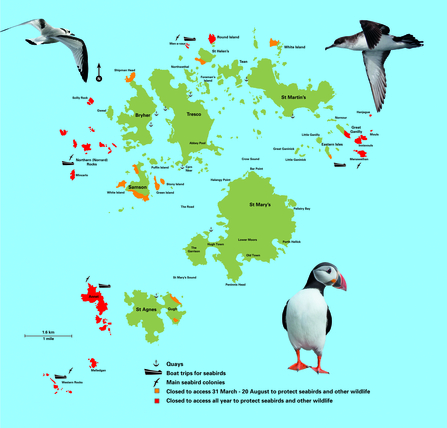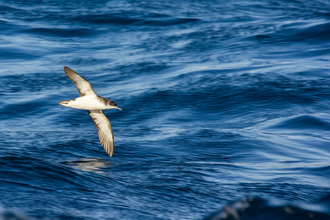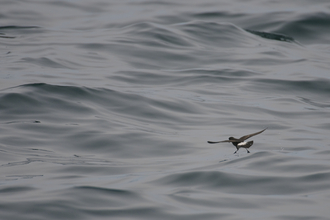How to spot seabirds on Scilly
Enjoy Scilly's iconic seabirds
The Isles of Scilly are of huge importance to seabirds. Thirteen species breed around the archipelago, plus we get multiple visiting species, too. Some are easy to see no matter where you are, like some of our gull species, shags that stand sentry on the rocks or gannets diving in the bays. Others require a bit more of an adventure, and you'll need to head out on a wildlife sea safari to experience them fully. Even more than that, in the summer months of July and August, head further offshore on a pelagic to see stunning species including skuas, big shearwaters and petrel species.
Any seabird adventure on Scilly starts the moment you board the Scillonian III. On the crossing, you'll be in with a chance of spotting auks (like guillemots and razorbills), gannets, gulls and even Manx shearwaters. Even if you fly over, you might spot gannets from the air as they plummet into the water. Gulls cry out and circle over Hugh Town and the harbour, and shags stand proudly on the rocks all around the main inhabited islands.
To experience the full impact of a bustling seabird colony, you need to head out on a wildlife sea safari between April and July. The Norrad Rocks, Annet and the Western Rocks and the Eastern Isles all offer opportunities to spot different species, including the comical and universally popular puffin. Kittiwakes, cormorants and fulmars are all possible species, too. It's advisable to use binoculars to spot seabirds, as this will help you keep disturbance to a minimum and get a good view. Manx shearwaters are more commonly spotted later in the day as they form rafts before heading back to their burrows at night, so a good opportunity to see them is to watch a gig race on a warm, sunny evening.
If you're lucky enough to head further offshore in the summer on a pelagic trip, then rarer species are a possibility. The chance to see Cory's and great shearwaters attracts huge numbers of birders in the July and August, and Scilly is one of the best places to spot Wilson's storm-petrels, which breed in Antarctica. You might also see great, Arctic or pomarine skuas, or even Sabine's gulls from America. Of course, cetaceans are also highly possible, especially on still days with flat calm seas. Scilly is also known for turning up 'mega' rarities, including Fea's petrels. In 2020, the first sighting of a Zino's petrel occurred in UK waters, showing that you never know what you might encounter.
Around the shores, you might see several coastal species that aren't strictly seabirds, like oystercatchers, turnstone or ringed plovers. Keep dogs on leads on beaches and stay well clear to avoid disturbance, as they might be nesting and are very sensitive.

Surveying Scilly's seabirds
Regular all-island counts of seabirds have been completed since 1970, and in the spring, summer and autumn our Seabird Ecologist, Dr Vickie Heaney, works across the islands to coordinate and conduct archipelago-wide surveys of all seabird species. The survival of our seabirds is threatened by the pollution, over-exploitation and degradation of our marine and coastal habitats, and our surveys allow us to identify ways that we can help them.
In some cases, they reveal some startling trends, including a reduction in the overall number of breeding seabird pairs between 1983 and 2016 of 31%. Annual counts of Annet's breeding numbers have fallen by 29% since 2000. Common terns have also suffered, with total breeding failure in several of the last few surveys. Kittiwakes are also threatened, showing an 89% drop in numbers and loss of 5 sub-colonies since 2006. They failed to breed entirely in 2021. Herring gull, lesser black-backed gull and shag breeding populations have all declined by over 20% since 2006.
However, the successful removal of rats from St Agnes and Gugh in 2013 has resulted in the first successful breeding of Manx shearwaters on those islands in living memory, as well as the first confirmed breeding by storm petrels in 2015. Manx shearwater numbers have trebled from 171 pairs in 2006 to 523 pairs in 2015. Since 2006 there has been a marked increase in the numbers of both razorbill and guillemots across the islands, whilst puffins have remained relatively stable.
Find out more
Find out more about Scilly's seabirds and how you can help them below.


